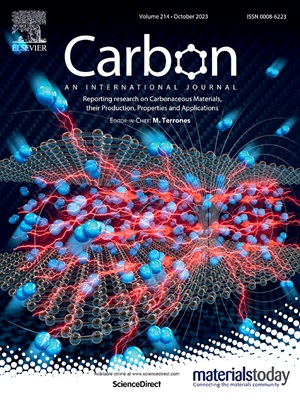Fe3C/石墨碳干凝胶作为绿色制氢电催化剂
IF 10.5
2区 材料科学
Q1 CHEMISTRY, PHYSICAL
引用次数: 0
摘要
水电解制氢是化石燃料的可持续替代品,其中析氢反应(HER)是关键步骤。提高这一过程的效率需要改善HER中所涉及的电催化剂的性能和耐久性。本研究通过探索碳酸氢盐缓冲介质与碳化铁(Fe3C)基碳干凝胶催化剂的结合,解决了传统酸性电解质催化活性高但长期稳定性差的局限性。开发了三种不同的水热合成路线,以优化催化剂的形貌和孔隙率。其中,在水-乙醇溶液(CX-S3)中延迟加入NH4OH的方法获得了最有希望的结果。该方法制备的碳干凝胶具有高介孔率、小且相互连接的颗粒和良好的微介孔结构。这些特性促进了质子进入封装的Fe3C活性位点,从而提高了电化学性能。在0.1 M KHCO3电解液中,CX-S3在−0.77 V vs. RHE下连续运行8 h,氢气输出稳定在7262.4 ppm。虽然催化剂在酸性条件下表现出更快的初始动力学,但在更高的电流密度下,由于降解,其性能下降。相比之下,碳酸氢盐缓冲液提供了一个更稳定的环境,能够持续产氢并保持催化剂的完整性。本文章由计算机程序翻译,如有差异,请以英文原文为准。

Fe3C/graphitic carbon xerogels as electrocatalysts for green hydrogen production
Hydrogen production via water electrolysis offers a sustainable alternative to fossil fuels, with the hydrogen evolution reaction (HER) serving as a key step. Enhancing the efficiency of this process requires improving the performance and durability of the electrocatalysts involved in HER. This study addresses the limitations of traditional acidic electrolytes which offer high catalytic activity but poor long-term stability by exploring the use of bicarbonate buffer media in combination with iron carbide (Fe3C)-based carbon xerogel catalysts. Three distinct hydrothermal synthesis routes were developed to optimize the catalysts morphology and porosity. Among them, the method involving the delayed addition of NH4OH in a water–ethanol solution (CX-S3) produced the most promising results. This approach yielded a carbon xerogel with high mesoporosity, small, interconnected particles, and a favorable micro–mesoporous structure. These features facilitated improved proton access to the encapsulated Fe3C active sites, resulting in enhanced electrochemical performance. In 0.1 M KHCO3 electrolyte, CX-S3 achieved a stable hydrogen output of 7262.4 ppm at −0.77 V vs. RHE during 8 h of continuous operation. While the catalyst demonstrated faster initial kinetics in acidic conditions, its performance deteriorated at higher current densities due to degradation. In contrast, the bicarbonate buffer provided a more stable environment, enabling sustained hydrogen production and preserving catalyst integrity.
求助全文
通过发布文献求助,成功后即可免费获取论文全文。
去求助
来源期刊

Carbon
工程技术-材料科学:综合
CiteScore
20.80
自引率
7.30%
发文量
0
审稿时长
23 days
期刊介绍:
The journal Carbon is an international multidisciplinary forum for communicating scientific advances in the field of carbon materials. It reports new findings related to the formation, structure, properties, behaviors, and technological applications of carbons. Carbons are a broad class of ordered or disordered solid phases composed primarily of elemental carbon, including but not limited to carbon black, carbon fibers and filaments, carbon nanotubes, diamond and diamond-like carbon, fullerenes, glassy carbon, graphite, graphene, graphene-oxide, porous carbons, pyrolytic carbon, and other sp2 and non-sp2 hybridized carbon systems. Carbon is the companion title to the open access journal Carbon Trends. Relevant application areas for carbon materials include biology and medicine, catalysis, electronic, optoelectronic, spintronic, high-frequency, and photonic devices, energy storage and conversion systems, environmental applications and water treatment, smart materials and systems, and structural and thermal applications.
 求助内容:
求助内容: 应助结果提醒方式:
应助结果提醒方式:


